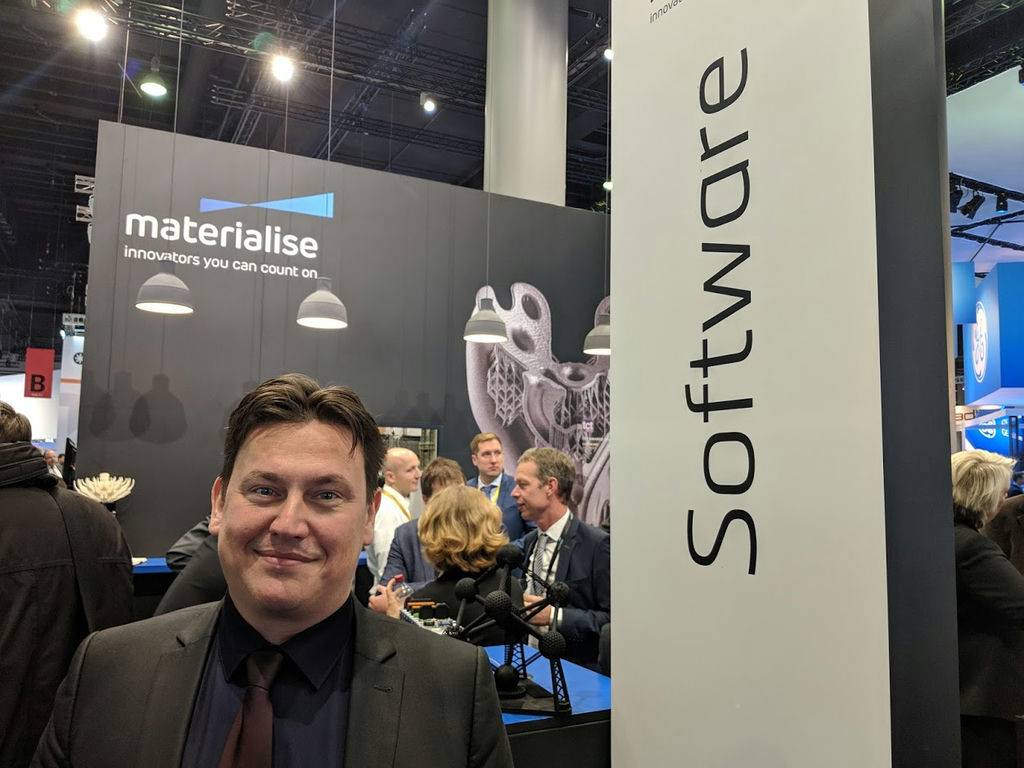[ihc-hide-content ihc_mb_type=”show” ihc_mb_who=”reg” ihc_mb_template=”3″ ]
[vc_row][vc_column][vc_column_text]Credits – www.fabbaloo.com
Last week in Frankfurt, I sat down with Stefaan Motte, Vice President and General Manager of Software at Materialise, to catch up on the latest from the Belgium-based mainstay company. Having spoken relatively recently about Materialise’s three decades of experience in 3D printing, this time Motte and I looked ahead.
“We can begin with a broader picture of what we’ve been talking about, which is two main pillars: productivity and connectivity,” Motte said as we sat down, ready to continue our conversation about a productive software space for 3D printing.
“With Magics 23, we have simulation released that is usable — not a mathematical workbench, but a tool that fits into people’s thinking. There are automation tools now in Magics that are saving hours. Releases are focused on productivity and connectivity, as we look at additive manufacturing and its penetration into applications, this has always been a pretty closed ecosystem, where productivity has always been a big hurdle for mass production.”
[/vc_column_text][vc_column_text]To ease the way into industrial additive manufacturing, just after our conversation Materialise announced a partnership with BASF and Essentium at formnext.
With Materialise as a co-investor (alongside what the announcement calls “a syndicate of private venture investors”), BASF is leading a Series A investment round in Essentium as the three complementary companies begin their work together. BASF and Essentium have already been working together on higher mechanical strength FFF (or FDM) 3D printing with the latter’s FlashFuse technology; the partnership now expands to create a global materials supply chain for Essentium’s High Speed Extrusion (HSE) platform. Materialise comes in to develop software for Essentium’s 3D printing technology.
“This is very well aligned for additive manufacturing in industrial applications,” Motte told me of the partnership. “Breakthroughs in machine speed are big, and they’re a big believer in productivity. We’re developing software specific to their machine and really moving productivity into FDM. We’re leveraging it all here: it’s a very productive technology that will conquer industrial FDM. The partnership exemplifies the strengths of all three parties together, jointly bringing to customers and Industry 4.0 their value.”
[/vc_column_text][vc_column_text]While serial production with 3D printing proved a major focus at formnext 2018, extrusion-based technologies are not often in this particular spotlight. The greater strength possible with Essentium’s hardware is enabling new potential, though, and Materialise and BASF are keen to see production-capable technology move toward FFF.
Another significant focus at formnext this year was simulation, as software takes its place in center stage as well with more advances geared toward first-time-right production.
“Simulation is popping up everywhere; you see differences in real usable simulation making an impact in manufacturing, but you also see ‘simulation’ used as buzz,” Motte noted. “We are working with Simufact, not just from a technology, but a usability point of view: what does the engineer need? Every day there is something different, and we are giving the engineer tools to make decisions on a day-to-day basis.”
That focus on the engineer — the actual daily user — makes Materialise’s Magics 23 release interesting, Motte added, “because it is usable, it is actually bringing value.”
“There is a transition in additive manufacturing, which has gone from prototyping to one-offs to mass customization, and you see this happening now into serial production. It will still take years. You see this popping up with big manufacturers only when it makes sense functionally speaking. When the advantages like lower weight and logistics offset the higher part price. Otherwise, price-per-part is continuing to limit adoption,” Motte continued.
“Manufacturing companies see the benefits of additive manufacturing, they know about design freedoms. But you hear about how the material price needs to come down; ultimately, it’s the total price that needs to come down.”
[/vc_column_text][vc_single_image image=”4362″ img_size=”full” add_caption=”yes”][vc_column_text]If additive manufacturing cannot compete on a price-per-part basis with traditional technologies, there is little practical reason for manufacturing companies to invest in pricey new equipment with different design parameters. Such realities often outweigh the well-touted benefits of additive manufacturing, which still sees significant barriers to entry especially in scale production volumes.
“We’re in an enabling position to help. The cards are there, and the mindset change is now finding its way to serial manufacturing, which will come in the coming years. Companies are using our software, and are making it happen. This enabling position, with all these companies using our software, is helping spread the reach of realizable additive manufacturing,” Motte explained.
Such enablement of new technologies and ways of thinking is well within Materialise’s expansive wheelhouse. Given their experience in introducing and bringing to market new solutions, often developed with an impressive selection of partners, the company is well positioned to continue on its leadership role in advancing solutions.
“Look at the steps Materialise has taken over the last years, with co-creating; all that was done with that mindset of normalizing production. The future ahead is making it normal as a production technology. We need that productivity, and we also need that connectivity that is often described as Industry 4.0. Going into serial production, that connectivity is crucial,” he continued.
With production set to be normalized as an application for 3D printing, I asked what has become my favorite question in positioning: when will it be boring? I didn’t especially care how the table we sat at had been made, just that it had been, and held our coffees; when will 3D printing be so boring?
“We are working on that boring future! There will be more cool stuff,” he said, gesturing at the mammoth bones in the room, “but also boring. The underlying technology in ‘boring’ is itself very exciting; look at machine learning. Real success is in creating both normal things and advanced science.”
The AM Chronicle Editorial Team is a collective of passionate individuals committed to delivering insightful, accurate and engaging stories to additive manufacturing audiences worldwide.



